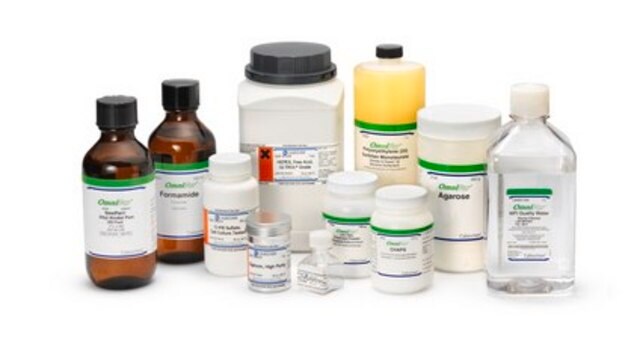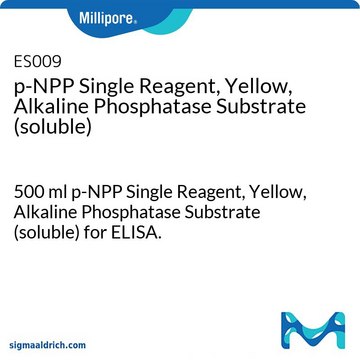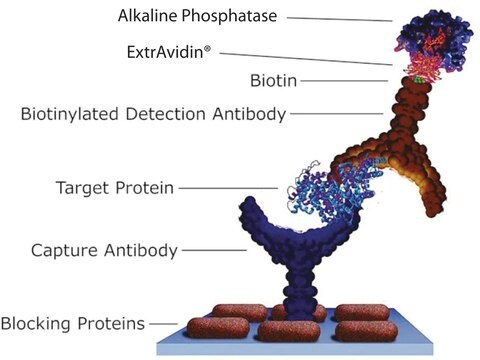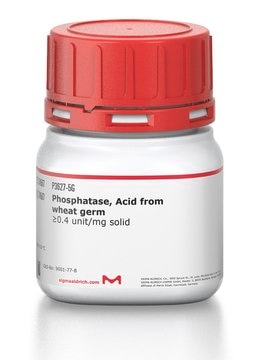487664
p-Nitrophenyl Phosphate Substrate Buffer
This p-Nitrophenyl Phosphate Substrate Buffer is validated for use in ELISA.
Anmeldenzur Ansicht organisationsspezifischer und vertraglich vereinbarter Preise
Alle Fotos(1)
About This Item
UNSPSC-Code:
41116158
NACRES:
NA.77
Empfohlene Produkte
Allgemeine Beschreibung
Alkaline phosphatase substrate buffer supplied as ready-to-use. A diluent for Cat. No. 487663.
This p-Nitrophenyl Phosphate Substrate Buffer is validated for use in ELISA.
Anwendung
ELISA (see comments)
Biochem./physiol. Wirkung
Primary Target
Alkaline phosphatase substrate buffer
Alkaline phosphatase substrate buffer
Product does not compete with ATP.
Warnhinweis
Toxicity: Standard Handling (A)
Sonstige Hinweise
Product tested for stability at 4°C, 18-26°C, and 37°C. Product performance is tested on the final product by ELISA.
Suggested procedure for use of p-NPP in alkaline phosphatase-based ELISAs:
1. To 39 parts distilled water add 1 part 50X p-NPP Concentrate (Cat. No. 487663) and 10 parts p-NPP Substrate Buffer. Mix well and store protected from light. This diluted reagent is suitable for up to 10 h after preparation.
2. Complete all required incubations with antibodies and alkaline phosphatase-labeled probes.
3. Wash plate wells at least 4 times with Tris-buffered saline (TBS) containing 0.1% Tween®-20 detergent. DO NOT USE PHOSPHATE BUFFERS; inorganic phosphate is a potent inhibitor of alkaline phosphatase.
4. After the final wash, shake and blot all residual buffer from the wells.
5. Add 100 µl of 1X p-NPP Substrate Solution to each well and incubate for 15-60 min. (If a kinetic study is desired, readings at 405 nm may be taken at intermediate intervals).
[Note: Optimal incubation times may vary depending on the amount of enzyme present. If color develops too quickly, dilution of the probe, antibody, or alkaline phophatase-labeled reagent may be required.]
6. Stop the reaction by adding 100 µl of 1 N NaOH.
7. Read absorbance at 405 nm.
Note: Variations in time, reagent volumes, and temperature may require further standardization by the user.
Suggested procedure for use of p-NPP in alkaline phosphatase-based ELISAs:
1. To 39 parts distilled water add 1 part 50X p-NPP Concentrate (Cat. No. 487663) and 10 parts p-NPP Substrate Buffer. Mix well and store protected from light. This diluted reagent is suitable for up to 10 h after preparation.
2. Complete all required incubations with antibodies and alkaline phosphatase-labeled probes.
3. Wash plate wells at least 4 times with Tris-buffered saline (TBS) containing 0.1% Tween®-20 detergent. DO NOT USE PHOSPHATE BUFFERS; inorganic phosphate is a potent inhibitor of alkaline phosphatase.
4. After the final wash, shake and blot all residual buffer from the wells.
5. Add 100 µl of 1X p-NPP Substrate Solution to each well and incubate for 15-60 min. (If a kinetic study is desired, readings at 405 nm may be taken at intermediate intervals).
[Note: Optimal incubation times may vary depending on the amount of enzyme present. If color develops too quickly, dilution of the probe, antibody, or alkaline phophatase-labeled reagent may be required.]
6. Stop the reaction by adding 100 µl of 1 N NaOH.
7. Read absorbance at 405 nm.
Note: Variations in time, reagent volumes, and temperature may require further standardization by the user.
Rechtliche Hinweise
CALBIOCHEM is a registered trademark of Merck KGaA, Darmstadt, Germany
TWEEN is a registered trademark of Croda International PLC
Analysenzertifikate (COA)
Suchen Sie nach Analysenzertifikate (COA), indem Sie die Lot-/Chargennummer des Produkts eingeben. Lot- und Chargennummern sind auf dem Produktetikett hinter den Wörtern ‘Lot’ oder ‘Batch’ (Lot oder Charge) zu finden.
Besitzen Sie dieses Produkt bereits?
In der Dokumentenbibliothek finden Sie die Dokumentation zu den Produkten, die Sie kürzlich erworben haben.
Kunden haben sich ebenfalls angesehen
Unser Team von Wissenschaftlern verfügt über Erfahrung in allen Forschungsbereichen einschließlich Life Science, Materialwissenschaften, chemischer Synthese, Chromatographie, Analytik und vielen mehr..
Setzen Sie sich mit dem technischen Dienst in Verbindung.













